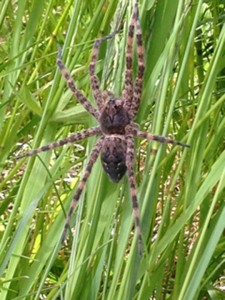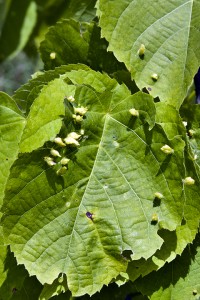Dark fishing spider (Dolomedes tenebrosus) is a large, robust, nursery web spider (family Pisauridae). The common name is misleading, as this spider is most often found in deciduous forests, often far from water.
This is the largest fishing spider (genus Dolomedes). The adult female body can be up to 1″ long with a legspan of over 3″. The male is about half that size and one-fourteenth the weight. The body is light brown with dark markings and the legs have alternating light and dark bands.
The male never survives the mating process. This is not because it is killed by the female, as with black widow spiders. The male has evolved to die spontaneously after mating, providing the female with a meal to nourish her eggs.
Fishing spiders are similar to, and often mistaken for, wolf spiders. They are distinguished by the arrangement of their eyes and the mode of perching. Dark fishing spider is similar in appearance to striped fishing spider (Dolomedes scriptus) but is larger and has less white marking on the abdomen.
http://minnesotaseasons.com/Arachnids/dark_fishing_spider.html


